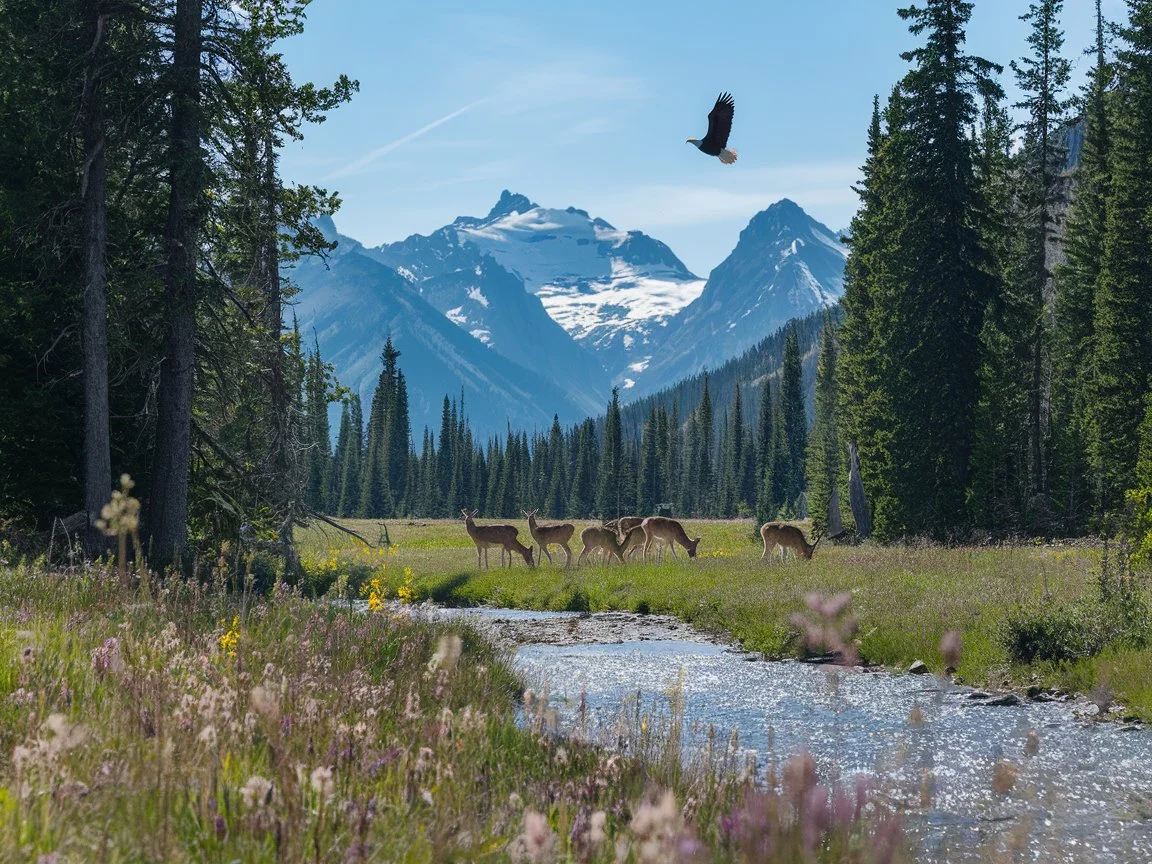
Introduction
Wildlife watching in mountain environments is a captivating and peaceful activity that allows you to observe animals in their natural habitats. From the majestic elk grazing in alpine meadows to the soaring eagles circling above, the mountains are teeming with life. This immersive experience not only brings you closer to nature but also fosters a deeper appreciation for the delicate balance of ecosystems.
Wildlife watching is more than just a hobby—it’s a way to connect with the natural world and gain insight into the behaviors and habits of animals. Whether you’re a seasoned wildlife enthusiast or a beginner, the mountains offer endless opportunities to spot a variety of species. This guide will take you through the best locations for wildlife watching, the animals you might encounter, and tips for observing them safely and ethically. So grab your binoculars, pack your camera, and get ready to explore the wild side of the mountains.
1. Best Locations for Wildlife Watching in the Mountains
The mountains are home to some of the most diverse and abundant wildlife habitats. Here are three top destinations for wildlife watching:
- Location 1: Yellowstone National Park, Wyoming
- Description: Yellowstone is a wildlife enthusiast’s paradise, home to bison, wolves, grizzly bears, and elk. The Lamar Valley, often called the “Serengeti of North America,” is one of the best spots for viewing these animals.
- Key Species: Bison, wolves, grizzly bears, elk, and bald eagles.
- Location 2: Rocky Mountain National Park, Colorado
- Description: This park offers stunning mountain scenery and a variety of wildlife, including elk, mule deer, and bighorn sheep. The Moraine Park area is particularly popular for wildlife watching.
- Key Species: Elk, mule deer, bighorn sheep, and black bears.
- Location 3: Denali National Park, Alaska
- Description: Denali is a remote and rugged park known for its large mammals and breathtaking landscapes. The park’s vast wilderness is home to grizzly bears, moose, and Dall sheep.
- Key Species: Grizzly bears, moose, Dall sheep, and caribou.
2. Common Mountain Animals to Spot
The mountains are home to a wide variety of animals. Here’s a look at some of the most common species you might encounter:
- Mammals:
- Bears: Black bears and grizzly bears are often spotted foraging for food in meadows and forests.
- Deer: Mule deer and white-tailed deer are common in mountain regions.
- Elk: These large herbivores are often seen grazing in open meadows.
- Mountain Goats: Known for their agility, mountain goats can be spotted on steep, rocky slopes.
- Birds:
- Eagles: Bald eagles and golden eagles are often seen soaring above mountain peaks.
- Hawks: Red-tailed hawks and Cooper’s hawks are common predators in mountain areas.
- Owls: Great horned owls and northern pygmy owls are nocturnal hunters found in forests.
- Reptiles & Amphibians:
- Snakes: Garter snakes and rattlesnakes are often found in rocky areas.
- Lizards: Western fence lizards and sagebrush lizards are common in dry, sunny spots.
- Frogs: Pacific tree frogs and boreal chorus frogs can be found near water sources.
3. Best Times and Seasons for Wildlife Watching
The time of year and time of day can greatly influence your wildlife-watching experience.
- Spring & Summer:
- Highlights: Many animals are active during these seasons, with abundant food and mating behaviors.
- Tips: Look for bears foraging for berries and elk grazing in meadows.
- Fall:
- Highlights: Fall is a time of migration and preparation for winter.
- Tips: Watch for elk during the rutting season and birds migrating south.
- Winter:
- Highlights: Winter offers unique opportunities to track animals in the snow.
- Tips: Look for winter-adapted species like bighorn sheep and snowshoe hares.
4. Techniques for Spotting Wildlife Safely
Observing wildlife requires patience, skill, and respect for the animals.
- Binoculars & Cameras:
- Use binoculars to get a closer look without disturbing the animals. A camera with a zoom lens is ideal for capturing photos from a distance.
- Patience & Stealth:
- Move quietly and avoid sudden movements. Stay downwind to prevent animals from detecting your scent.
- Time of Day:
- Early mornings and late afternoons are the best times to spot wildlife, as many animals are most active during these periods.
5. Safety Tips for Wildlife Watching
Safety is paramount when observing wildlife in their natural habitat.
- Respecting Boundaries:
- Keep a safe distance from animals. Use binoculars or a zoom lens to observe them up close.
- Wildlife Encounters:
- If you encounter a bear, remain calm, speak softly, and back away slowly. Do not run or make sudden movements.
- Staying Safe in Remote Areas:
- Carry a first-aid kit, bear spray, and a satellite communicator for emergencies.
6. Ethical Wildlife Watching
Responsible wildlife watching ensures that animals and their habitats are protected.
- Minimizing Your Impact:
- Stay on designated trails and avoid disturbing wildlife.
- Leave No Trace:
- Pack out all trash and avoid feeding animals.
- Conservation Efforts:
- Support local conservation organizations and initiatives that protect wildlife habitats.
7. Combining Wildlife Watching with Other Mountain Activities
Wildlife watching can be paired with other outdoor activities for a well-rounded experience.
- Hiking and Wildlife Watching:
- Choose trails that pass through prime wildlife habitats, such as meadows and forests.
- Photography:
- Capture the beauty of wildlife through your lens while respecting their space.
- Camping and Wildlife Viewing:
- Set up camp near wildlife-rich areas and enjoy the sights and sounds of nature.
Conclusion
Wildlife watching in the mountains is a rewarding and enriching experience that allows you to connect with nature and observe animals in their natural habitats. By choosing the right locations, practicing ethical wildlife watching, and staying safe, you can make the most of your adventure. So grab your gear, head to the mountains, and immerse yourself in the wonders of the wild. Remember, the mountains are calling—will you answer?
You can see more at Cabin Mountains – The Best Outdoor Activities for Your Mountain Cabin Escape

